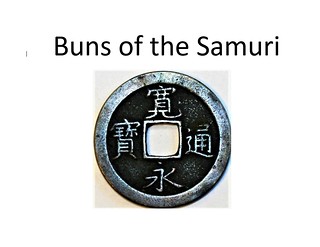
PREV ARTICLE
NEXT ARTICLE
FULL ISSUE
PREV FULL ISSUE
NEW MONOGRAPH: BUNS OF THE SAMURI
Ted Puls has published a new monograph on varieties of The Japanese mint mark
"This is a short pamphlet about varieties of The Japanese mint mark Here's an excerpt from the pamphlet's Introduction. -Editor
No this isn't a cooking topic but
These coins were initially cast by private minters but finally were controlled by the Shogan's mints (maybe formally the Emperor's mints). The invention of the Kan Ei Tsu Ho design was in 1625, in the third year of the imperial era called Kan Ei. Private minting of coinage was approved to help the needs of commerce. A more consistent coinage was needed than private enterprise could produce so the government took control and started casting what is now called
One of the
Because of the Buddhist practice of placing thin squares of gold leaf on the Buddha, the coins were reputed to have a quantity of gold in them making them very desirable. Due to the special source of metal in these coins was also reputed to prevent the ill effects of tobacco when a pipe could be cast from them. Despite this special heritage, twelve other mints competed to produce coinage with different mint marks plus others without a specific mintmark. Because of the popularity of this coinage, the name continued long after the Era of Leniency ended (ca. 1675), into the eighth year of To request a copy, contact Ted at: tedkate@comcast.net -Editor Wayne Homren, Editor The Numismatic Bibliomania Society is a non-profit organization promoting numismatic literature. See our web site at coinbooks.org. To submit items for publication in The E-Sylum, write to the Editor at this address: whomren@gmail.com To subscribe go to: https://my.binhost.com/lists/listinfo/esylum All Rights Reserved. NBS Home Page Contact the NBS webmaster 
|




